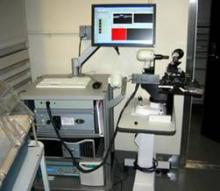BOSTON – Retinal changes over time mirror global central nervous system processes in patients with multiple sclerosis, according to findings from a longitudinal study comparing optical coherence tomography and magnetic resonance imaging findings.
The results validate optical coherence tomography (OCT) measures for both clinical monitoring of patients, and as an outcome measure in clinical trials, and could have implications that reach beyond MS, Dr. Shiv Saidha said at the joint meeting of the European and Americas committees for Treatment and Research in Multiple Sclerosis.
In 107 multiple sclerosis (MS) patients with a mean age of 44 years and median disease duration of 10 years who underwent biannual high-definition spectral-domain OCT with automated intraretinal segmentation for a mean of 46 months, and baseline and annual 3T magnetic resonance imaging including substructure volumetrics for a mean of 39 months, a significant association was seen over time between the rate of ganglion cell layer plus inner plexiform layer (GCIP) atrophy and the rate of whole brain atrophy (r = 0.45). The association was mainly driven by the relationship between GCIP thinning and cortical gray matter atrophy (r = 0.37), said Dr. Saidha of Johns Hopkins University, Baltimore.
"These results remained significant after correction for multiple comparisons, and they were verified by a number of additional statistical techniques," he said.
Adjustment was made for age, gender, MS subtype, disease duration, and history of optic neuritis.
With respect to subtype analyses, there also was a significant relationship between the rate of GCIP thinning and lesion accumulation (r = 0.30), and between the rate of inner nuclear layer (INL) atrophy and lesion accumulation (r = 0.28), in patients with relapsing-remitting MS. Thus, GCIP atrophy also mirrors lesion accumulation as well as brain atrophy (but to a lesser degree), and INL solely mirrors lesion accumulation and could also provide information regarding global inflammation, he said.
Additionally, the association between GCIP thinning and whole brain atrophy rate was stronger in patients with primary progressive MS (r = 0.54) – and particularly so in secondary progressive MS (r = 0.73) – than in those with relapsing-remitting MS (r = 0.33).
Optic neuritis in this study appeared to be relevant, he said, noting that with each of three sequential refinements for optic neuritis history (one model included all eyes with optic neuritis, one excluded all eyes with optic neuritis, and a third excluded all patients with any history of optic neuritis), a stepwise increase in the correlation between the rate of GCIP thinning and whole brain atrophy was seen.
"We did not observe a similar effect in secondary progressive MS. One possibility for this is that immediately following an optic neuritis event, you get this rapid disproportionate localized tissue injury which is sensitively captured with OCT, and the rate of brain change remains unchanged at that point. Then, as time goes on, the two rates (the rate of change in retinal and brain measures) may become realigned again in the future," he said.
The findings of this study are notable, because optic neuropathy is "virtually ubiquitous" as part of the MS disease process, with postmortem studies showing that up to 99% of patients have demyelinating plaques within their optic nerves at the time of death.
"The hypothesis is that demyelination within the optic nerve and/or transection of axons related to acute inflammation result in retrograde degeneration of the constituent fibers of the optic nerve," Dr. Saidha said, explaining that these fibers are derived from the innermost layer of the retina (the retinal fiber layer), that the axons are derived from the ganglion cell neurons from the ganglion cell layer, and that therefore, optical neuropathy results in atrophy of both the retinal nerve fiber and ganglion cell layers.
The majority of available studies looking at the relationship between OCT and brain substructure metrics have been cross-sectional, so a critically unanswered question is whether OCT really has utility in terms of tracking patients longitudinally.
"In other words, does atrophy or change within specific retinal layers parallel global concomitant neurodegeneration, which is really the principal correlate of disability in MS," he said, adding that the ways in which these relationships might vary by MS subtype has been "virtually unexplored."
Also, a history of optic neuritis has been shown on a cross-sectional level to potentially blunt or mask relationships between OCT measures and MRI, perhaps related to excessive localized tissue injury immediately following the optic neuritis; this raised the question of whether a history of optic neuritis is relevant to the interpretation of OCT measures over time for tracking patients.


